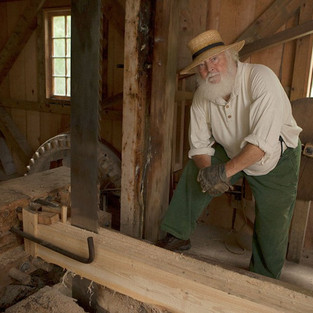Exploring the USA: Mackinac Island
- Pamela Guffey
- Feb 24, 2021
- 6 min read

As we venture further in our quest to explore the beauty of the USA, we turn north and travel to the shores of Lake Huron in Michigan. This is where we find the quaint Mackinac Island where time has stood still and calls visitors back to discover many treasures of the past.
During the Victorian Era, Mackinac (MACK-in-awe) became one of the nation’s favored summer resort destinations. Vacationers wishing to escape the heat of the city, arrived in large lake-excursion boats from nearby bustling metropolitan areas to relax and play in the cooler climate of the island. They danced to Strauss’ waltzes, listened to Sousa’s stirring marches, dined on whitefish, and strolled along the broad decks. To accommodate overnight guests, boat and railroad companies financed the building of Grand Hotel, which still beckons guests today to enjoy the time honored traditions that have been part of the hotel since its beginnings.
One of the most noticeable differences on Mackinac Island (which is accessible only by boat and plane) is the absence of automobiles. Visitors and residents travel by foot, bicycle or horse-drawn carriage.
The Grand Hotel

Since opening its doors in 1887 as a summer retreat for vacationers, Grand Hotel has beckoned guests to a "bygone era of old-world hospitality and charm". America's Summer Place, as the hotel is affectionately called, has been nurtured into the majestic icon of the island that it is today.
Imagine arriving at this noble dwelling. You first climb the steps to the world's longest front porch where you are enticed to relax in one of the multitude of rocking chairs and drink in the beauty of the Straits of Mackinac.
Step inside the lobby where you are greeted by hotel staff who escort you to one of the 388 individually decorated rooms, many of them named after prominent American figures. Would it not be a wonderful memory to share with friends after a weekend stay in the Lady Bird Johnson or Nancy Reagan Suite. These charming rooms are definitely worth several visits as each one is distinctly different in style and design.

After settling into your room, experience the tradition of Afternoon Tea in the Parlor followed by a game of bocce ball or croquet on the Lawn. Later you will return to your suite to dress for an elegant dinner in the dining room and finish off the evening in the ballroom dancing to the sounds of the Grand Hotel Orchestra.
Your days at Grand Hotel will be filled with swimming in the massive Ester Williams pool, shopping in the quaint boutiques, sharing a confectionary favorite at Sadie's ice cream parlor, being pampered at Astor's Salon and Spa, hitting the links for 18 holes on the stunning THE JEWEL golf course, and marveling at the sites and smells of the exquisite gardens surrounding the hotel — and this is just what you will encounter on Grand Hotel grounds. There is so much more to Mackinac Island...
Mackinack Island
Fort Mackinac --
History comes alive at this fort that dates back to the American Revolution and was an active military garrison until 1985. and history comes alive. The oldest building in Michigan and 13 other historical structures boast exhibits explaining everything from military training and battles to medical treatments to family life within the fort.
More than just a military outpost, Fort Mackinac served as a home for soldiers and their families and eventually the headquarters for Mackinac National Park, where tourists to the island visited the great fortress on the bluff, much like they do today.
Old Mackinac Point Light Station-- First operational in 1889, the vessels traveling the Straits of Mackinac were protected for 65 years by the devotion of four generations of lighthouse keepers and their families. The lighthouse complex included a tower and attached duplex, fog signal building and storage barn. Take the time to climb the stairs of this steadfast beacon and put yourself in the footsteps of the loyal guiders of ships from years gone by. Colonial Michilimackinac Historical Site-- In 1715 French soldiers constructed Fort Michilimackinac. This fortified community became the great fur trade center of the Northwest until its relocation to nearby Mackinac Island in 1781. It was here that fur traders and Indians rendezvoused, French and British officers organized war parties and explorers began their journeys into the vast western unknown.
As you walk through the site, you are stepping back in time to 1778, when rumors of war and peace swirled around Michilimackinac. Here, you will see and hear how soldiers, civilians, and Native people responded to threats real and imagined as they attempted to maintain their livelihood, the fur trade. Historical interpreters representing voyageurs, British soldiers, and French-Canadian merchant families are stationed throughout the fort to answer your questions and perform demonstrations.
Biddle House--
Walk into the lives of Agatha and Edward Biddle, merchants who moved in around 1830. Explore the story of Agatha and her heritage as an Anishinabek woman, an indigenous people group from the region. Learn how her story, and that of other indigenous group in the area, shaped the culture of the region and continues to have an impact even in modern times.
Historic Mill Creek Discovery Park
The smell of sawdust penetrates the air at one of the oldest industrial sites on the Upper Great Lakes that has been reconstructed to its former use. Established in 1790 by Robert Campbell to provide sawn lumber for nearby Mackinac Island, Mill Creek sawmill, along with a farm, extensive orchard, and gristmill, played an important part in the thriving community until the 1830's.
Come gain a new appreciation of the hard work and dedication it took to build our homes and businesses from natural resources as you observe sawyers demonstrate the pit saw method of cutting lumber.
The Discovery Park also offers the thrill of adventure with a guided experience taking you into, above and through the northern Michigan forest. Scale the five-story Treetop Discovery Tower, taking in bird calls along the way. Brave the Forest Canopy Bridge, high above Mill Creek that explores the under story of the forest. Finally, fly like an eagle down the 425′ Eagle’s Flight Zip Line while spotting fish in the creek.
Mackinac Art Museum --
Nowhere else does such a rare and exceptional collection of Mackinac-related art and photography come together to tell Mackinac’s story. In complement to the natural beauty of Mackinac Island, The Richard and Jane Manoogian Mackinac Art Museum allows visitors to experience fine and decorative arts inspired by Mackinac through the ages.
One of the most diverse art museums in the region, the museum’s collection offers no shortage of beauty and history – from hand-beaded Native American garments and 17th and 18th-century maps of the Great Lakes, to one-of-a-kind pieces from the height of Mackinac Island’s Victorian era.
Original photographs from the mid-19th to the mid-20th century present the beauty of Mackinac as captured by the camera’s eye. Featured are the works of William H. Gardiner, including dozens of his famed early-twentieth century hand-tinted views.
Historic Downtown Mackinac --
Before Mackinac Island became the summer playground for many vacationers, it was the main supply center and trading post for the upper Great Lakes fur trade. Pelts were gathered and shipped to US and European markets, bringing great wealth into the Mackinac region.
Follow in the footsteps of the fur traders as you visit downtown and the historic Benjamin Blacksmith Shop, a working 1950s-era blacksmith, the American Fur Company Store and Dr. Beaumont Museum, as well as the McGulpin House, perhaps the oldest private residence in Michigan.

Mackinac Island State Park --
Michigan's first state park has a rich history. It began as Mackinac National Park, the second of the United States National Parks. Twenty years later, in 1895, it was established as Mackinac Island State Park. Today, over eighty percent of Mackinac Island is State Park property, and most of this park land remains in its natural condition to be enjoyed.
A great variety of historic and natural resources provides something of interest for every Mackinac Island visitor. Historic landmarks, breathtaking vistas, spectacular rock formations, quiet forests and inspiring nature trails are just minutes away.
Michilimackinac State Park -- Michigan’s Second State Park is home to Colonial Michilimackinac and Old Mackinac Point Lighthouse, and the best view of the Mackinac Bridge available. The park was established in 1909. and is located at the tip off Michigan’s lower peninsula. You are sure to find some of the most picturesque and breathtaking photo-ops as you explore the park.
Come take a look at what treats and treasures Mackinac Island has to offer as you stroll the grounds, pedal the backroads, observe the workers of yesteryear, and venture into a time long ago when everyday life was hard work but the joys of the times were simple and fun. Bring the family and learn the art of relaxing, rejuvenating and re-engaging with each other in a place full of beauty, history and enjoyment.
Contact your Diserella Travel Consultant today to find out how to make Mackinac Island your favored Summer place this year.
About the Author:

Pamela has been visiting the Walt Disney World parks for over 30 years, first as a child herself and most recently with her granddaughter.
Contact her today to start planning your magical vacation.











Comments